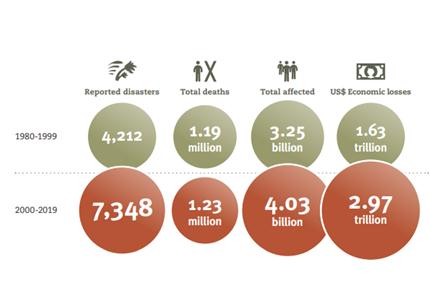‘The Human Cost of Disasters 2000-2019- UNDRR’
-
Context
In a recent report “The Human Cost of Disasters 2000-2019”, the United Nations pointed out that climate change is largely to blame for a near doubling of natural disasters in the past 20 years.
-
Background
- The report was published to mark the International Day for Disaster Risk Reduction.
- International Day for Disaster Risk Reduction is observed on October 13, every year.
- It confirms extreme weather events have come to dominate the disaster landscape in the 21st century.
- The report did not touch on biological hazards and disease-related disasters like the coronavirus pandemic
About UNDRR
- The UN Office for Disaster Risk Reduction was established in 1999 and serves as the focal point in the United Nations System for the coordination of disaster risk reduction.
- It supports the implementation of the Sendai Framework for Disaster Risk Reduction 2015-2030, which maps out a broad people-centered approach towards achieving a substantial reduction in disaster losses from natural and man-made hazards and a shift in emphasis from disaster management to disaster risk management.
-
What are the Key Findings?
- In the period 2000 to 2019, there were 7,348 major recorded disaster events claiming 1.23 million lives, affecting 4.2 billion people (many on more than one occasion) resulting in approximately US$2.97 trillion in global economic losses.
- The last twenty years has seen the number of major floods more than double, from 1,389 to 3,254, while the incidence of storms grew from 1,457 to 2,034. Floods and storms were the most prevalent events.
- The sharp increase was largely attributable to a rise in climate-related disasters, including extreme weather events like floods, drought and storms.
- It also recorded major increases in other categories including drought, wildfires and extreme temperature events.
- Asia has suffered the highest number of disasters in the past 20 years with 3,068 such events, followed by the Americas with 1,756 and Africa with 1,192.
- In terms of affected countries, China topped the list with 577 events followed by the United States with 467.
- A warming climate appeared to be driving the number and severity of such disasters
- There has also been a rise in geo-physical events including earthquakes and tsunamis which have killed more people than any of the other natural hazards
- The deadliest single disaster in the past 20 years was the 2004 Indian Ocean tsunami, with 226,400 deaths, followed by the Haiti earthquake in 2010, which claimed some 222,000 lives.
-
What are the Major Concerns?
- A temperature increase of 3°C of the global climate is estimated to increase the frequency of potentially high impact natural hazard events across the world. This could render current national and local strategies for disaster risk reduction and climate change adaptation obsolete in many countries.
- Shifting rainfall patterns and greater variability in precipitation poses a risk to the 70% of global agriculture that is rain-fed and the 1.3 billion people dependent on degrading agricultural land.
-
What are the Recommendations?
- The concentrated impact due to a single disaster type in some countries provides an opportunity for a more focused approach on disaster risk reduction.
- COVID-19 demonstrates the need for a systemic, multi hazard approach in an increasingly globalized and inter-connected world;
- There is a requirement for strengthening disaster risk governance to manage disaster risk with clear vision, competence, plans, guidelines, funding and coordination across sectors and in a manner which takes account of the increasingly systemic nature of disaster risk.
- Public and private investment in disaster risk prevention and reduction through structural and non-structural measures needs to be stepped up to create disaster resilient societies.
Disaster Impacts: 1980-1999 vs. 2000-2019


